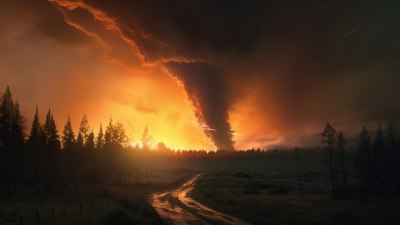What the Color of the Sky Tells You About the Weather
Explore how the sky's colors reveal weather changes, from clear days to storms, and learn to read atmospheric clues.

The color of the sky is more than a beautiful backdrop to our daily lives; it is a dynamic indicator of weather conditions. By observing the sky's hues, from bright blue to fiery red or ominous gray, we can gain valuable insights into upcoming weather phenomena. Understanding these natural signals helps in predicting weather changes and preparing accordingly.
Different colors in the sky occur due to the interaction of sunlight with atmospheric particles, moisture, and pollutants. The scattering of sunlight, primarily caused by molecules and particles in the atmosphere, influences the sky's appearance at various times of the day and under different weather conditions.
Why is the Sky Blue?
The most common color of the sky on a clear day is blue. This is due to a phenomenon called Rayleigh scattering. Sunlight is composed of multiple colors, each with different wavelengths. When sunlight enters the Earth's atmosphere, shorter wavelengths such as blue and violet scatter more than longer wavelengths like red and yellow. Our eyes are more sensitive to blue light and the upper atmosphere absorbs much of the violet, so the sky appears predominantly blue.
A bright, deep blue sky typically indicates very clean air with low levels of moisture and pollutants. This often correlates with stable weather conditions and high atmospheric pressure, meaning little or no precipitation is expected.
What Does a Pale or Washed-Out Sky Mean?
Sometimes the sky appears pale blue or washed out. This happens when the atmosphere contains more water vapor or fine particles like dust, haze, or pollution. These particles scatter all wavelengths of light more evenly, reducing the vividness of blue. A pale sky can be a sign of increasing humidity or approaching weather fronts with moisture. For example, haze early in the day may indicate that rain or storms could develop later.
The Significance of Red and Orange Skies
Red or orange skies are especially noticeable during sunrise and sunset, but they can also offer clues about the weather. The saying “Red sky at night, sailor’s delight; red sky in morning, sailors take warning” is rooted in these observations.
At sunrise and sunset, sunlight travels through a thicker layer of atmosphere, scattering shorter wavelengths and allowing longer red and orange wavelengths to dominate. A red sky at night typically indicates clear weather approaching because the setting sun is shining through dust and dry air, suggesting a high-pressure system arriving.
Conversely, a red sky in the morning can mean that a high-pressure system has passed and a low-pressure system, which brings moisture and precipitation, is moving in. This may lead to rain or storms during the day.
Gray Skies and Cloud Cover
Gray or overcast skies generally indicate extensive cloud cover. The shade of gray can vary according to the thickness and type of clouds present. Light gray skies might suggest thin clouds that won't produce much precipitation, while dark gray skies often signal thick, moisture-laden clouds ready to release rain or snow.
Cloud types also correlate with weather patterns. For instance, nimbostratus clouds form thick gray layers that bring steady rain or snow, while cumulonimbus clouds are towering and dark gray, often associated with thunderstorms. Observing these can help anticipate intensity and type of precipitation.
White and Bright Skies
Sometimes, especially on humid days or during partial cloud cover, the sky appears white or very bright. This usually results from a combination of sunlight scattering and the presence of thin clouds or fog. A white sky often indicates moisture in the air, which may lead to mist, fog, or drizzle. It also suggests that the sun’s rays are diffused and not strong — useful for gauging UV exposure and weather conditions.
The Meaning Behind Pink Skies
Pink skies are less common but can appear near sunrise or sunset. The pink hue occurs when sunlight is scattered by fine particles and moisture droplets in the lower atmosphere. Like red and orange skies, pink skies can indicate incoming weather changes, often preceding a storm or shift in weather systems depending on timing and locality.
Greenish Skies and Their Weather Implications
A greenish tint to the sky is relatively rare but is sometimes observed before severe storms, especially tornadoes or hailstorms. The green color is thought to result from the scattering of light by water droplets and ice crystals mixed within storm clouds. When combined with intense lighting during thunderstorms, this effect may indicate that severe weather is imminent and should be taken seriously.
Night Sky Colors and Weather Foretelling
At night, the sky’s color can also provide weather clues. A clear night sky filled with stars generally forecasts calm weather because it suggests low humidity and stable atmospheric pressure. Conversely, a bright, diffuse glow caused by moonlight shining through clouds can imply overcast conditions with possible precipitation.
Additionally, the color and brightness of the moon or stars may illustrate atmospheric conditions. For example, a halo around the moon, appearing as a white or rainbow ring, often predicts upcoming storms due to ice crystals in high-altitude cirrostratus clouds.
How Pollution Influences Sky Colors
Pollution can dramatically change the sky’s color, sometimes making it appear brown, gray, or even yellowish. Urban environments with high smog levels tend to feature these duller or even unnatural tones. Such coloration indicates the presence of airborne particulate matter and chemical pollutants, which impact both weather and health.
While pollution doesn't directly forecast weather, it can alter local weather patterns by changing cloud formation, sunlight penetration, and temperature. Additionally, pollution's impact on sky color can confuse natural weather signals, making it important to distinguish human-induced colors from natural atmospheric changes.
Scientific Instruments and Sky Color Observations
Meteorologists use instruments like spectrometers and sky color sensors to better interpret the sky's hues in relation to weather phenomena. These tools analyze the spectrum of light to detect particles, moisture levels, and pollutants in the air, improving weather predictions. However, even without instruments, careful observation of sky color remains a valuable and accessible method to understand weather trends.
Using Sky Color for Everyday Weather Prediction
Simple observations of sky color and changes throughout the day can help individuals anticipate weather patterns. For example, a bright blue sky in the morning usually means a pleasant day, while increasing cloud cover with gray hues toward noon may warn of afternoon showers. Likewise, striking red sunsets can signal stable weather, while red sunrises warn of incoming rain.
Farmers, sailors, and outdoor enthusiasts have long relied on these natural indicators to plan work and travel, demonstrating the practical significance of sky color beyond aesthetics.
Sky Color Changes with Seasons
The color of the sky varies with seasons due to changes in sunlight angle, atmospheric moisture, and pollution levels. For instance, winter skies can appear paler or grayer with frequent overcast conditions, while summer skies are often a vivid blue due to drier air. Seasonal changes in humidity and particulate matter also influence morning and evening sky colors, affecting weather interpretation.
Interpreting Sky Color in Different Geographic Regions
Geography influences sky color through atmospheric composition and local weather patterns. Coastal areas may have hazier skies due to sea salt particles and humidity, while deserts exhibit brilliant blue skies with minimal moisture. Urban areas experience more pollution-related color shifts, while mountainous regions may see more vibrant sunrises and sunsets because of altitude and cleaner air.
Understanding these regional differences is crucial for accurate weather interpretation through sky color observations.
Observing Sky Color During Extreme Weather
Before and during severe weather events, sky colors can become unusual or intense. Storm clouds deepening to charcoal black or purple signal strong thunderstorms. A yellow or brownish tint might precede dust storms or floods. These extreme color changes alert observers to dangers and the need for immediate action.
Watching how sky color evolves during such events can provide critical information about storm strength and movement, benefiting both individuals and emergency services.
The Role of Light Pollution in Night Sky Perception
In urban areas, light pollution skews the natural colors of the night sky, washing out stars and reducing the visibility of sky-based weather clues. This makes observing celestial events and atmospheric phenomena more difficult, impacting weather predictions based on sky color.
Efforts to reduce light pollution, such as using shielded lighting and minimizing unnecessary outdoor lights, help restore natural night sky colors and support better weather observation and ecological balance.
In summary, the colors of the sky offer a fascinating, accessible way to gauge weather conditions. From the clear blue days of high pressure to the dramatic reds signaling changes in pressure zones, understanding sky color is a timeless skill that connects us with the atmosphere and nature's rhythms. By learning to read these natural signals, we can better anticipate weather changes, stay safe, and appreciate the dynamics of the world's weather systems.











